Pregnancy-Induced Hypertension (PIH)-妊娠高血压(妊高征)
妊娠高血压综合征Pregnancy-inducedhypertentionsyndrome(一)

妊娠高血压综合征Pregnancy-inducedhypertentionsyndrome(一)妊娠高血压综合征,简称Pregnancy-induced hypertension syndrome (PIH),是指在孕妇怀孕期间出现的血压升高并伴有一系列临床表现,如蛋白尿、水肿、头痛等。
PIH影响了孕妇的身体和胎儿的健康,需要及时治疗和管理。
1. 妊娠高血压的原因PIH的原因较为复杂,可能与孕期内的生化、代谢功能改变、母体血管紧张度调控失常、免疫功能发生变化等多种因素有关。
如果孕妇患有慢性高血压、糖尿病、肾脏疾病等基础疾病,PIH的发病率更高。
2. PIH的临床表现PIH的症状主要包括血压升高、蛋白尿、水肿、头痛、视力模糊、上腹部疼痛等。
其中,血压升高是PIH的主要特征,如果孕妇血压值大于140/90mmHg,应及时就医。
3. PIH的危害PIH对孕妇和胎儿都有不良影响。
孕妇会出现高血压脑病、肝功能异常、肾功能障碍等严重病变,甚至导致死亡。
而胎儿则容易发生先兆早产、宫内发育迟缓、胎盘早期剥离等问题,增加死亡和残疾风险。
4. PIH的防治措施PIH的防止措施主要包括:孕前应做好健康检查,治疗慢性疾病;孕期应注意控制体重、均衡饮食、适度运动;孕期初期就应该监测血压,每周一次至孕晚期,每天监测一次,定期复查尿常规等。
如果确诊PIH,则需要及时治疗和管理,孕妇应注意休息、饮食调理,减轻血压,评估胎儿发育和监控胎心,有需要时采取剖腹产手术。
5. 综合治疗措施综合治疗PIH需要考虑孕妇和胎儿的健康因素。
药物治疗应以降低血压为主,尽量选择安全性高、副作用小的药物。
同时也需注意胎儿的安全,建议在医生指导下使用。
监测前胎儿心率、胎儿重量和胎盘流量等指标,定期复查尿和血液检查,及时处理各种并发症。
6. 总结PIH是孕妇常见的疾病,发病率较高,需引起重视。
孕妇应定期进行体检和血压监测,减少患病的风险。
一旦出现症状,应及早就医,根据病情进行综合治疗,保护孕妇和胎儿健康。
《妊娠期血压管理中国专家共识》要点

《妊娠期血压管理中国专家共识》要点1.诊断与分类:- 妊娠期高血压(Pregnancy-induced hypertension,PIH):孕妇在妊娠20周后血压增高,无蛋白尿和药物治疗前无肝功能异常。
-先兆子痫前期:除了PIH的血压增高外,尿液中还有大量蛋白,但无其他肝肾功能异常的表现。
-先兆子痫:在PIH和先兆子痫前期的基础上,伴有肝肾功能异常、凝血异常等。
-妊娠合并慢性高血压疾病:在妊娠前已经存在的慢性高血压,在妊娠时仍然持续存在或加重。
2.诊断标准:- 收缩压≥140 mmHg或舒张压≥90 mmHg,至少在2次测量间隔15分钟以上。
- 先兆子痫前期的血压阈值:收缩压≥140 mmHg或舒张压≥90 mmHg,并至少在2次测量间隔4小时以上,同时伴有尿蛋白量≥0.3 g/24小时或定量尿蛋白/肌酐比值≥0.33.高危因素:-既往有妊娠期高血压疾病史、慢性高血压疾病史。
-30岁以上孕妇。
- BMI ≥30 kg/m2-多胎妊娠。
-孕前高血压或糖尿病。
4.血压控制策略:-建议孕妇每2周至少一次产前检查血压。
-非药物治疗:合理饮食、避免剧烈体力活动、恰当的休息、保持适当体重。
-药物治疗:选择安全有效的药物,如甲基多巴、硝苯地平、拉贝洛尔等。
5.风险评估与监测:-孕妇的风险评估包括病史、生活方式、实验室检查等。
-孕妇每4周体重测量一次,每半月测量尿蛋白量。
-每月进行一次心脏听诊、血液生化、尿常规等监测。
6.分娩及产后管理:-孕妇在血压稳定的情况下,应维持足月妊娠,避免早期分娩。
- 孕妇血压≥160/110 mmHg,或有持续性高血压,或有胎儿宫内窘迫等情况,需要早期分娩。
-产后高血压的诊断标准见第2点,产后管理需注意。
探讨拉贝洛尔联合硫酸镁治疗妊娠期高血压疾病的临床效果
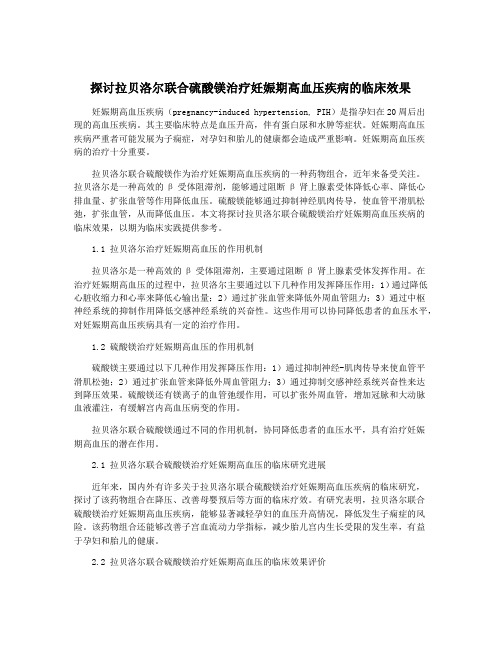
探讨拉贝洛尔联合硫酸镁治疗妊娠期高血压疾病的临床效果妊娠期高血压疾病(pregnancy-induced hypertension, PIH)是指孕妇在20周后出现的高血压疾病。
其主要临床特点是血压升高,伴有蛋白尿和水肿等症状。
妊娠期高血压疾病严重者可能发展为子痫症,对孕妇和胎儿的健康都会造成严重影响。
妊娠期高血压疾病的治疗十分重要。
拉贝洛尔联合硫酸镁作为治疗妊娠期高血压疾病的一种药物组合,近年来备受关注。
拉贝洛尔是一种高效的β受体阻滞剂,能够通过阻断β肾上腺素受体降低心率、降低心排血量、扩张血管等作用降低血压。
硫酸镁能够通过抑制神经肌肉传导,使血管平滑肌松弛,扩张血管,从而降低血压。
本文将探讨拉贝洛尔联合硫酸镁治疗妊娠期高血压疾病的临床效果,以期为临床实践提供参考。
1.1 拉贝洛尔治疗妊娠期高血压的作用机制拉贝洛尔是一种高效的β受体阻滞剂,主要通过阻断β肾上腺素受体发挥作用。
在治疗妊娠期高血压的过程中,拉贝洛尔主要通过以下几种作用发挥降压作用:1)通过降低心脏收缩力和心率来降低心输出量;2)通过扩张血管来降低外周血管阻力;3)通过中枢神经系统的抑制作用降低交感神经系统的兴奋性。
这些作用可以协同降低患者的血压水平,对妊娠期高血压疾病具有一定的治疗作用。
1.2 硫酸镁治疗妊娠期高血压的作用机制硫酸镁主要通过以下几种作用发挥降压作用:1)通过抑制神经-肌肉传导来使血管平滑肌松弛;2)通过扩张血管来降低外周血管阻力;3)通过抑制交感神经系统兴奋性来达到降压效果。
硫酸镁还有镁离子的血管弛缓作用,可以扩张外周血管,增加冠脉和大动脉血液灌注,有缓解宫内高血压病变的作用。
拉贝洛尔联合硫酸镁通过不同的作用机制,协同降低患者的血压水平,具有治疗妊娠期高血压的潜在作用。
2.1 拉贝洛尔联合硫酸镁治疗妊娠期高血压的临床研究进展近年来,国内外有许多关于拉贝洛尔联合硫酸镁治疗妊娠期高血压疾病的临床研究,探讨了该药物组合在降压、改善母婴预后等方面的临床疗效。
妊娠高血压分级的标准
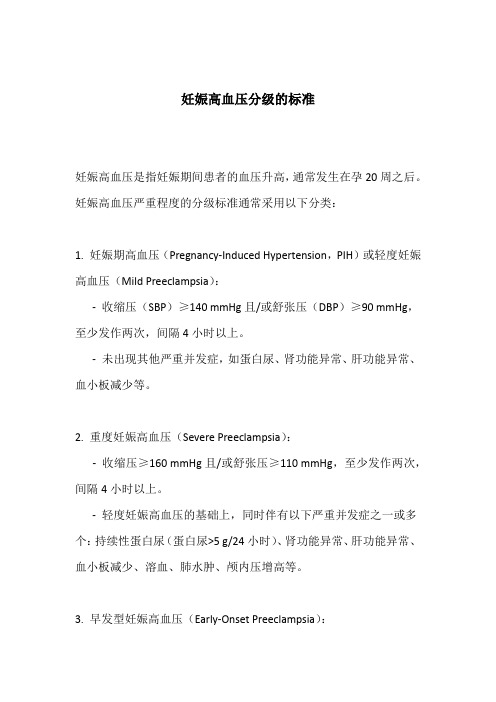
妊娠高血压分级的标准
妊娠高血压是指妊娠期间患者的血压升高,通常发生在孕20周之后。
妊娠高血压严重程度的分级标准通常采用以下分类:
1. 妊娠期高血压(Pregnancy-Induced Hypertension,PIH)或轻度妊娠高血压(Mild Preeclampsia):
-收缩压(SBP)≥140 mmHg且/或舒张压(DBP)≥90 mmHg,至少发作两次,间隔4小时以上。
-未出现其他严重并发症,如蛋白尿、肾功能异常、肝功能异常、血小板减少等。
2. 重度妊娠高血压(Severe Preeclampsia):
-收缩压≥160 mmHg且/或舒张压≥110 mmHg,至少发作两次,间隔4小时以上。
-轻度妊娠高血压的基础上,同时伴有以下严重并发症之一或多个:持续性蛋白尿(蛋白尿>5 g/24小时)、肾功能异常、肝功能异常、血小板减少、溶血、肺水肿、颅内压增高等。
3. 早发型妊娠高血压(Early-Onset Preeclampsia):
-孕20周至孕34周+6天之间出现妊娠高血压和蛋白尿。
-早发型妊娠高血压通常与胎儿生长迟缓和血流动力学异常等相关。
4. 妊娠高血压伴子痫前期(Preeclampsia Superimposed on Chronic Hypertension):
-妊娠期高血压或慢性高血压的基础上,出现血压升高和蛋白尿。
妊娠高血压分级的标准可能会在不同的指南和机构之间略有差异,因此在实际应用中应参考相关权威指南或咨询医生以获得具体的诊断
和治疗建议。
早发现和适时管理妊娠高血压对于妊娠妇女和胎儿的健康至关重要。
妊娠期高血压疾病指南最新版

妊娠期高血压疾病指南最新版妊娠期高血压疾病(pregnancy-induced hypertension,简称PIH)是指在孕妇妊娠20周后,尿蛋白≥30mg/dl或≥1+,但没有明显肾脏损害的高血压状态。
这种疾病严重危害孕妇和胎儿的健康,因此合理有效的预防和治疗至关重要。
为此,最新版的妊娠期高血压疾病指南提供了一系列的专业建议和指导。
一、定义和分类根据最新版指南,妊娠期高血压疾病被分为以下几种类型:1. 子痫前期:血压升高,但没有伴随肾脏功能异常和终末器官受损。
2. 子痫:在子痫前期的基础上进一步发展,伴随肾脏功能异常和终末器官受损。
3. 妊娠期高血压:孕妇在妊娠20周后出现血压升高,但没有伴随尿蛋白增多。
4. 孤立性小于30周的高血压:孕妇在妊娠20周后出现血压升高,但没有伴随尿蛋白增多,并且在妊娠30周前就已经稳定。
二、预防和筛查预防是最重要的措施之一,孕妇应该在孕前就开始预防措施,如合理控制饮食、适度运动、减轻工作压力等。
另外,定期进行孕检也是及早发现和治疗妊娠期高血压的重要手段。
三、诊断和监测妊娠期高血压的诊断主要依靠孕妇的生命体征和生化指标。
血压测量是非常关键的步骤,孕妇应该定期测量血压并记录下来。
此外,尿蛋白的测定也是诊断和监测的必要手段。
四、治疗和护理治疗和护理是妊娠期高血压患者必须要重视的环节。
根据病情的不同,治疗方法也有所区别。
一般情况下,孕妇需要卧床休息、限制盐摄入、控制体重等。
对于病情较为严重的患者,则需要及时进行药物治疗。
五、并发症和不良结局妊娠期高血压疾病如果得不到及时有效的治疗,会引发一系列严重的并发症,如在胎儿方面可能导致胎死宫内、早产等,而在孕妇方面则可能引发心脏病、肾脏病等。
因此,治疗和管理过程中需注意及时发现和处理并发症,以预防不良结局的发生。
六、孕妇管理的重要性针对妊娠期高血压疾病,孕妇的管理占据了核心地位。
孕妇应该积极配合医生的治疗和护理,坚持定期产检和随访,配合好药物治疗,注意饮食和心理状况的调节等。
妊娠高血压综合征
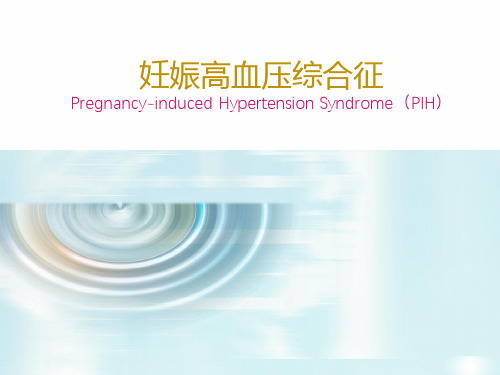
毒性反应:肾功能不全,用药剂量大,可发生血镁积聚,血镁浓度达5 mmol/L时,可出现肌肉兴奋性受抑制,感觉反应迟钝,膝腱反射消 失,呼吸开始受抑制,血镁浓度达6mmol/L时可发生呼吸停止和心律 失常,心脏传导阻滞,浓度进一步升高,可使心跳停止。
解毒:10%葡萄糖酸钙10ml静脉推注,时间大于3分钟。 必要时每小时重复一次,直至呼吸、排尿和神经抑制恢复正常,
轻度子痫前期患者入院不需负荷量,每天维持量(15g)。
肌肉注射
25%硫酸镁20ml+2%利多卡因2ml,深部肌肉注射,每日1-2次
每日总量为25-30g
硫酸镁不良反应
◦ 静脉注射硫酸镁常引起潮红、出汗、口干等症状,快速静脉注射时可 引起恶心、呕吐、心慌、头晕,个别出现眼球震颤,减慢注射速度症 状可消失。
2.减轻疼痛 2.1.采取舒适卧位, 2.2.如果为剖宫产及时系腹带,减轻伤口张力。 2.3.遵医嘱给予止痛剂。 2.4.护理操作应轻柔、集中,减少移动病人将尿管和输液管固定好, 以防活动时牵拉疼痛。 2.5.教会病人有效咳嗽,咳嗽时轻按伤口。 2.6.采取各种措施如听音乐等,转移病人对疼痛的注意力。
健康宣教:
1 、向病人解释妊娠高血压疾病的原因症状体征治疗及预后,讲解本 病对母婴的影响,使孕妇了解并定期检查。
2 、给予饮食指导:应增加蛋白质,维生素以及含铁钙锌的食物,减 少适量脂肪和盐的摄入。
3 、创造安静清洁舒适的环境,保证充分的休息,卧床休息应以左侧 卧位为宜,避免平卧位,避免各种刺激。
。其他镇 静药
苯巴比妥、吗啡等具有较好的抗惊厥、抗抽搐作用, 可用于子痫发作时控制抽搐及产后预发和控制子痫发 作。由于该要可致胎儿呼吸抑制,产前宜慎用。
硫酸镁是子痫治疗的一线药物,也是重度子痫前 期预防子痫发作的预防用药。
妊娠高血压研究报告总结

妊娠高血压研究报告总结研究背景妊娠期高血压(Pregnancy-Induced Hypertension, PIH)是指妊娠20周后,孕妇血压升高的一种疾病。
妊娠高血压是妊娠期最常见的并发症之一,对孕妇和胎儿的健康都有严重影响。
近年来,妊娠高血压的发病率呈上升趋势,成为全球关注的公共卫生问题。
因此,深入研究妊娠高血压的发病机制和预防措施具有重要意义。
研究目的本研究旨在总结近年来妊娠高血压的研究进展,分析其发病机制和影响因素,探讨预防和治疗的策略,为临床诊断和治疗提供参考。
研究方法本研究使用了系统综述的方法,对近十年以来相关的文献进行了收集和分析。
通过检索医学数据库和相关期刊,筛选出与妊娠高血压研究相关的论文。
经过研究小组的讨论和评估,最终确定了40篇文献作为研究样本进行综合分析。
研究结果1. 妊娠高血压的发病机制通过综合文献分析,发现妊娠高血压的发病机制非常复杂,包括孕激素水平的改变、血管内皮功能障碍、免疫系统异常等多个方面的因素。
其中,子宫血流动力学的异常与妊娠高血压关系密切,胎盘血流的异常也与妊娠高血压的发生有关。
2. 妊娠高血压的影响因素妊娠高血压的发病受多种因素的影响,包括孕妇的年龄、体重、孕前患有高血压疾病的家族史、糖尿病和肾脏疾病等。
此外,生活方式因素如饮食、运动、吸烟和饮酒等也可能增加妊娠高血压的风险。
3. 妊娠高血压的预防和治疗策略预防和治疗妊娠高血压是保障母婴健康的重要措施。
首先,建立规范的孕产管理制度,提高孕妇的健康素养和自我保健意识。
其次,积极干预孕妇的生活方式,如合理饮食、适量运动、戒烟限酒等。
在临床治疗方面,根据病情的轻重缓急,选择适当的药物治疗和手术干预,并根据孕妇和胎儿的情况进行个体化的治疗方案。
研究结论本研究通过系统综述的方法,总结了近年来妊娠高血压的研究进展。
研究发现妊娠高血压的发病机制非常复杂,多个因素相互作用。
妊娠高血压的发病与孕妇的个体因素、生活方式和孕期管理密切相关。
妊娠期高血压疾病患者的ICD-10编码分析
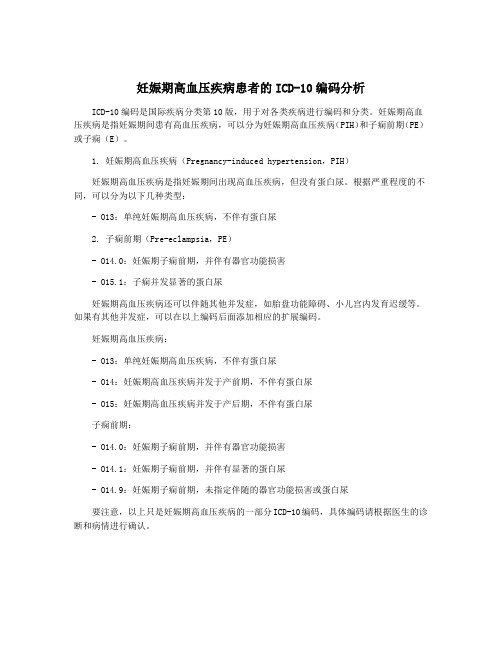
妊娠期高血压疾病患者的ICD-10编码分析
ICD-10编码是国际疾病分类第10版,用于对各类疾病进行编码和分类。
妊娠期高血压疾病是指妊娠期间患有高血压疾病,可以分为妊娠期高血压疾病(PIH)和子痫前期(PE)或子痫(E)。
1. 妊娠期高血压疾病(Pregnancy-induced hypertension,PIH)
妊娠期高血压疾病是指妊娠期间出现高血压疾病,但没有蛋白尿。
根据严重程度的不同,可以分为以下几种类型:
- O13:单纯妊娠期高血压疾病,不伴有蛋白尿
2. 子痫前期(Pre-eclampsia,PE)
- O14.0:妊娠期子痫前期,并伴有器官功能损害
- O15.1:子痫并发显著的蛋白尿
妊娠期高血压疾病还可以伴随其他并发症,如胎盘功能障碍、小儿宫内发育迟缓等。
如果有其他并发症,可以在以上编码后面添加相应的扩展编码。
妊娠期高血压疾病:
- O13:单纯妊娠期高血压疾病,不伴有蛋白尿
- O14:妊娠期高血压疾病并发于产前期,不伴有蛋白尿
- O15:妊娠期高血压疾病并发于产后期,不伴有蛋白尿
子痫前期:
- O14.0:妊娠期子痫前期,并伴有器官功能损害
- O14.1:妊娠期子痫前期,并伴有显著的蛋白尿
- O14.9:妊娠期子痫前期,未指定伴随的器官功能损害或蛋白尿
要注意,以上只是妊娠期高血压疾病的一部分ICD-10编码,具体编码请根据医生的诊断和病情进行确认。
妊娠期高血压-2024鲜版

2024/3/28
17
胎儿宫内生长受限应对策略
01
02
03
04
加强监测
定期进行产前检查,包括B超 、胎心监护等,及时发现胎儿 宫内生长受限的情况。
改善子宫胎盘血流
通过吸氧、改变体位等方法, 改善子宫胎盘血流,促进胎儿 生长发育。
营养支持
根据孕妇的营养状况,合理补 充蛋白质、维生素及矿物质等 营养素,满足胎儿生长发育的 需要。
对于子痫前期患者,除控制血压 外,还需使用硫酸镁等药物预防 子痫发作;若病情严重或药物治
疗无效,可考虑终止妊娠。
2024/3/28
14
04
并发症预防与处理
2024/3/28
15
心脑血管疾病预防
控制血压
通过药物治疗和生活方式调整,将血压控制在正常 范围内,减少心脑血管事件的风险。
定期监测
定期进行心电图、心脏超声等检查,及时发现并处 理心脏结构和功能的异常。
诊断标准
妊娠期高血压是指在妊娠20周后,出现收缩压≥140mmHg 和(或)舒张压≥90mmHg,且至少间隔4小时或以上的两 次测量均达到此标准。
诊断流程
首先进行详细的病史询问和体格检查,包括测量血压、心率 、呼吸频率等;其次进行必要的实验室检查,如尿常规、血 常规、肝肾功能等;最后根据临床表现和实验室检查结果进 行综合判断。
母乳喂养有助于降低产妇血压、减少心血管疾病 风险,同时也有益于母婴情感交流和婴儿健康成 长。
母乳喂养与妊娠期高血压的关系
研究表明,母乳喂养可降低妊娠期高血压的发生 率,可能与母乳喂养对内分泌系统的调节作用有 关。
母乳喂养建议
3
鼓励和支持妊娠期高血压产妇进行母乳喂养,同 时注意合理饮食和休息,以保持身体健康和良好 的哺乳状态。
妊娠期高血压病人麻醉药物的选择

妊娠期高血压病人麻醉药物的选择一、引言妊娠期高血压(Pregnancy-Induced Hypertension, PIH)是指妊娠20周以后出现血压升高,并伴随蛋白尿的一种临床综合征。
妊娠期高血压病人麻醉药物的选择需要综合考虑产妇的病情、胎儿的安全性以及药物的作用特点。
本文将对妊娠期高血压病人麻醉药物的选择进行详细探讨。
二、妊娠期高血压病人麻醉药物的选择原则1. 确保母婴安全:麻醉药物的选择应确保母婴的安全,避免药物对胎儿产生不良影响。
2. 药物作用迅速、可控:麻醉药物应具有快速起效、可控性强、作用时间短等特点,以满足手术需求。
3. 减轻心脏负荷:妊娠期高血压病人心脏负荷较重,麻醉药物的选择应减轻心脏负荷,避免诱发心力衰竭。
4. 个体化用药:根据病人的具体情况,如年龄、体重、肝肾功能等,合理选择麻醉药物,实现个体化用药。
5. 联合用药:根据手术类型和病人状况,合理搭配不同麻醉药物,以实现最佳麻醉效果。
三、常用麻醉药物及特点1. 局部麻醉药:局部麻醉药具有对循环系统影响小、作用时间可控等特点,适用于妊娠期高血压病人。
常用的局部麻醉药有普鲁卡因、利多卡因等。
2. 全身麻醉药:全身麻醉药包括吸入性麻醉药和静脉麻醉药。
吸入性麻醉药具有快速起效、可控性强等特点,适用于手术时间较长、病人循环系统较稳定的妊娠期高血压病人。
常用的吸入性麻醉药有异氟醚、七氟醚等。
静脉麻醉药具有对循环系统影响小、作用迅速等特点,适用于手术时间较短、病人循环系统较不稳定的妊娠期高血压病人。
常用的静脉麻醉药有丙泊酚、咪达唑仑等。
3. 麻醉性镇痛药:麻醉性镇痛药具有镇痛效果好、对循环系统影响小等特点,适用于妊娠期高血压病人。
常用的麻醉性镇痛药有芬太尼、舒芬太尼等。
4. 肌肉松弛药:肌肉松弛药可降低病人的肌肉张力,有利于手术操作。
常用的肌肉松弛药有阿托品、罗库溴铵等。
四、麻醉药物的选择与合理应用1. 术前评估:对妊娠期高血压病人进行全面评估,了解其病情、手术类型、肝肾功能等,为麻醉药物的选择提供依据。
妊娠高血压综征Pregnanyinuehyereninsynrme-V1

妊娠高血压综征Pregnanyinuehyereninsynrme-V1妊娠高血压综征(Pregnancy-induced hypertension syndrome,简称PIH)是指妊娠后期(20周以上)出现的血压升高,伴有水肿和/或蛋白尿等其他组织损害,但无其他致病因素的疾病综合征。
以下是PIH 的相关知识点:1. 病因PIH的病因尚不明确。
目前的研究认为常常与下列因素有关:- 胎盘造成孕妇体内一系列的生化和内分泌改变,促进PIH的发生和发展;- 维生素D、蛋白质和精氨酸等营养素缺乏可能引起PIH;- 氧化应激和炎症反应是PIH发展过程中的主要因素。
2. 发病率现代社会中的高血压高发人群,特别是有慢性高血压或家族遗传史的孕妇,更容易患上PIH。
妊娠高血压综合征的发生率为5%至10%不等。
3. 分类按照高血压的程度和其他组织损害的表现,PIH可分为轻度、中度和重度三种不同程度。
此外,PIH还可分为早发型和晚发型两种类型,具有不同的病因和临床表现。
4. 症状PIH的早期症状可能和正常孕妇生理表现相似,但随着病情的进展,孕妇可能出现下肢水肿、脸部水肿、头痛、眼前发黑、视力模糊、呼吸困难等症状。
如果夜间出现胸闷、咳嗽、喘息、呼吸窘迫等症状,需要尽快就医。
5. 检查本病的诊断需要根据临床表现和实验室检查结果综合分析,如血压监测、尿常规、尿白蛋白定量等。
如果有疑虑需要进一步检查,如血清肌酐、血清尿酸、血浆胆红素和血小板等。
6. 治疗PIH的治疗应及时、全面,包括对孕妇生活方式和心理状态的调整,药物治疗和及时引产等。
药物治疗必须在孕妇的医生指导下进行,因为某些用药会对胎儿造成损害,如ACEI、ARII和利尿剂等药物。
总之,PIH是高危妊娠并发症,孕妇进行产后监护,及时治疗,提高孕产妇的生存率和胎儿的生存率是非常必要的。
妊娠期高血压名词解释

妊娠期高血压名词解释妊娠期高血压 (Pregnancy-induced hypertension, PIH) 是一种在怀孕期间出现的一种血压异常。
妊娠期高血压是指孕妇在妊娠20周后血压达到140/90 mmHg或以上,而在妊娠前血压正常的情况下出现的。
妊娠期高血压可以分为两种类型:早发型妊娠期高血压(Early-onset PIH) 和晚发型妊娠期高血压 (Late-onset PIH)。
早发型妊娠期高血压是指在妊娠20周至妊娠34周之间出现的高血压。
这种类型的高血压通常与胎盘功能异常有关,胎盘无法提供足够的血液供应给胎儿,导致孕妇出现高血压。
早发型妊娠期高血压还可能导致胎儿发育迟缓、胎儿死亡或早产等并发症。
晚发型妊娠期高血压是指在妊娠34周之后出现的高血压。
这种类型的高血压通常是由孕妇体内的血管收缩剂(如血管紧张素)导致的,导致血管收缩和血液循环受阻,从而引起高血压。
晚发型妊娠期高血压可能会进一步发展为子痫前期,子痫前期是晚发型妊娠期高血压的一种严重形式,会导致器官功能损害。
妊娠期高血压可能有一些症状,包括头痛,视觉异常,呼吸困难,腰背痛,腿肿胀等。
然而,有些孕妇可能没有明显的症状,因此定期检测血压是非常重要的。
对于早发型妊娠期高血压的治疗,通常需要对胎儿进行监测,因为这种类型的高血压可能会对胎儿发育造成不利影响。
如果病情严重,可能需要在妊娠期间提前结束妊娠。
对于晚发型妊娠期高血压,医生可能会考虑给孕妇降低血压的药物治疗。
同时,定期检查孕妇的血压和尿蛋白水平也是很重要的。
最后,预防妊娠期高血压的最佳方法是定期进行孕妇体检,保持健康的生活方式,包括适量的运动和均衡的饮食。
如果孕妇有高血压疾病家族史或其他高危因素,应尽早告知医生,以便进行监测和干预。
妊高症的护理
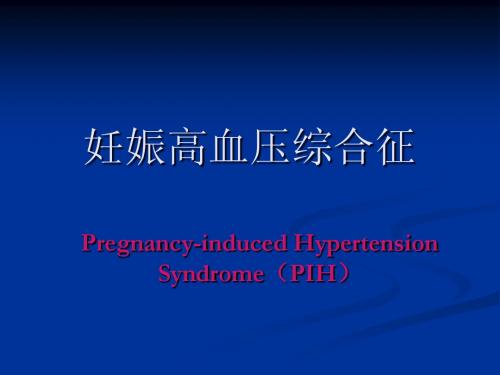
【护理措施】
(三)中、重度妊高征妇女的护理 1.休息 卧床休息,保证环境安静。 2.饮食 低盐饮食。 3.加强监护
(1)孕妇:包括血压、体重、尿蛋白以外,按需测 量肝、肾功能、心电图、B超等。 (2)胎儿:听胎心、测胎动,量宫高腹围等。
【护理措施】
(四)子痫病人的护理
1.制止抽搐 执行医嘱,使用MgSO4及镇静剂。 2.防止受伤 专人守护。 3.减少刺激 诊治措施要集中,避免光声刺激。 4.加强监护 包括母儿情况及产兆。 5.实施终止妊娠。
妊娠高血压综合征
Pregnancy-induced Hypertension Syndrome(PIH)
【定义】
简称妊高征。 指妊娠20周以后出现高血压、水肿、蛋白尿 三大症候群,严重者可出现抽搐、昏迷、 心肾功能衰竭,甚至发生母婴死亡。 是妊娠期特有的疾病。 目前病因尚未阐明。
【病理生理变化】—全身小动脉痉挛
1.治疗期间,病情得到控制。 2.治疗期间,没有出现硫酸镁中毒反应。 3.孕妇顺利分娩健康新生儿。 4.出院时,病人没有出现产后并发症。
轻度
+
中度 重度
+ 1+~4+
【临床分类】
1.先兆子痫 2.子痫
而骤然发生抽搐。 不同时期发作分别被称为产前子痫、产时子 痫、产后子痫。 自觉症状 抽搐发作或伴昏迷
少数病例病情进展迅速,先兆子痫症状不明显
【处理原则】
解痉 降压 镇静 合理扩容及利尿 适时终止妊娠
【护理评估】
(一)病史 了解孕期经过,既往及家族中 高血压病史等。 (二)身心状况 评估高血压、蛋白尿、水 肿症状出现时的经过情况,尤其重视有关 三大症状基础上自觉症状的主诉。 孕妇及其家属会表现出不同程度焦虑、 无助感。
妊娠期高血压的诊断与处理注意事项
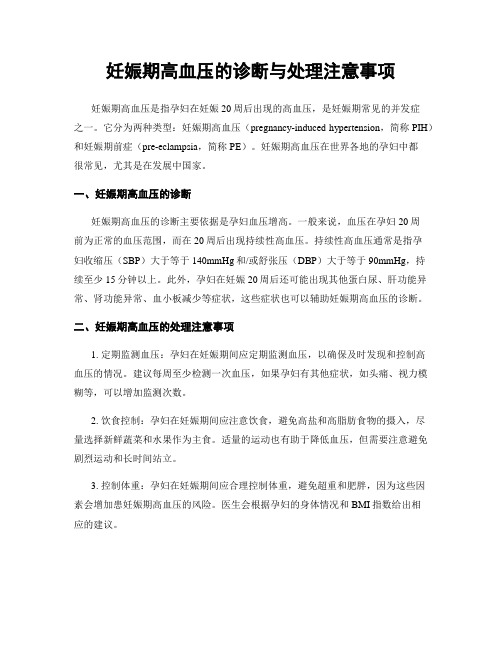
妊娠期高血压的诊断与处理注意事项妊娠期高血压是指孕妇在妊娠20周后出现的高血压,是妊娠期常见的并发症之一。
它分为两种类型:妊娠期高血压(pregnancy-induced hypertension,简称PIH)和妊娠期前症(pre-eclampsia,简称PE)。
妊娠期高血压在世界各地的孕妇中都很常见,尤其是在发展中国家。
一、妊娠期高血压的诊断妊娠期高血压的诊断主要依据是孕妇血压增高。
一般来说,血压在孕妇20周前为正常的血压范围,而在20周后出现持续性高血压。
持续性高血压通常是指孕妇收缩压(SBP)大于等于140mmHg和/或舒张压(DBP)大于等于90mmHg,持续至少15分钟以上。
此外,孕妇在妊娠20周后还可能出现其他蛋白尿、肝功能异常、肾功能异常、血小板减少等症状,这些症状也可以辅助妊娠期高血压的诊断。
二、妊娠期高血压的处理注意事项1. 定期监测血压:孕妇在妊娠期间应定期监测血压,以确保及时发现和控制高血压的情况。
建议每周至少检测一次血压,如果孕妇有其他症状,如头痛、视力模糊等,可以增加监测次数。
2. 饮食控制:孕妇在妊娠期间应注意饮食,避免高盐和高脂肪食物的摄入,尽量选择新鲜蔬菜和水果作为主食。
适量的运动也有助于降低血压,但需要注意避免剧烈运动和长时间站立。
3. 控制体重:孕妇在妊娠期间应合理控制体重,避免超重和肥胖,因为这些因素会增加患妊娠期高血压的风险。
医生会根据孕妇的身体情况和BMI指数给出相应的建议。
4. 药物治疗:对于妊娠期高血压患者,如果血压控制不佳,医生可能会考虑给予药物治疗。
但是,孕妇应该严格按照医生的指导用药,避免自行服用药物。
常用的降压药物包括甲基多巴、硝酸酯类药物和钙通道阻滞剂等。
5. 早产:在严重妊娠期高血压(PE)的情况下,早产可能是唯一的治疗方法。
这是因为PE会给母体和胎儿带来严重的风险,如子痫前期、胎儿宫内生长受限等。
医生会根据孕妇和胎儿的状况来决定是否需要早产。
- 1、下载文档前请自行甄别文档内容的完整性,平台不提供额外的编辑、内容补充、找答案等附加服务。
- 2、"仅部分预览"的文档,不可在线预览部分如存在完整性等问题,可反馈申请退款(可完整预览的文档不适用该条件!)。
- 3、如文档侵犯您的权益,请联系客服反馈,我们会尽快为您处理(人工客服工作时间:9:00-18:30)。
– Eclampsia:
• Pre-eclampsia + convulsions.
Superimposed pre-eclampsia or eclampsia:
– Development of pre-eclampsia or eclampsia in pre-existing hypertension detected by a further increase of 30 mmHg or more in systolic blood pressure or 15 mmHg or more in diastolic blood pressure.
Hypertensive Disorders in Pregnancy
Classification
1. PRE-EXISTING (CHRONIC) HYPERTENSION 2. PRE-ECLAMPSIA 1. Differential Diagnosis 2. Complications 3. Treatment 4. ECLAMPSIA
• Blood pressure falls by the second trimester in most of cases, but rises during the third trimester to a level some what above that in early pregnancy. • Deterioration of the underlying disease.
How to measure the blood pressure in pregnancy 3
• Let air out slowly so that mercury falls steadily by 2-3 mm/sec. • Blood pressure measurement phases (Korotkoff):
• Secondary to cardiovascular disease: e.g.
– Coarctation of the aorta. – Polyartheritis nodosa. – Systemic lupus erythematosus.
PRE-EXISTING (CHRONIC) HYPERTENSION
Pathological Changes
• Vasospasm • Coagulation status • Sodium and water retention
Diagnosis
• Signs • Symptoms
Signs
• Hypertension: • Proteinuria (albuminuria): • Oedema:
• Korotkoff I and IV is the reading for systolic and diastolic blood pressure respectively. If you wait the disappearance of the sound to take the diastolic reading (as in nonpregnant state) you may reach down to zero because of the hyperdynamic circulation during pregnancy.
PRE-EXISTING (CHRONIC) HYPERTENSION
Causes •iology. • Secondary to chronic renal disorder: e.g.
– – – – Glomerulonephritis. Hydronephrosis. Pyelonephritis. Renal artery stenosis.
How to measure the blood pressure in pregnancy 2
• The cuff should be applied to the right upper arm with the connecting tubes pointing downwards, the centre of the rubber bag in the cuff is directly over the brachial artery leaving ante-cubital fossa free. • Apply cuff firmly but not tightly around the arm. • Feel the brachial artery and apply the stethoscope directly over it without undue pressure. • Pump up cuff rapidly to 20-30 mmHg above the point at which the pulse sound disappears, and take blood pressure reading without delay.
How to measure the blood pressure in pregnancy 4
Theories
• • • • • • • The uteroplacental bed Immunological factor Genetic factor Renin- angiotensin system Atrial natriuretic peptide (ANP) Prostaglandins Neutrophils
Hypertension
• Blood pressure of 140/90 mmHg or more or an increase of 30 mmHg in systolic and/or 15 mmHg in diastolic blood pressure over the pre- or early pregnancy level.
PRE-ECLAMPSIA
• Incidence: 5-10%. • Aetiology: Although eclampsia had been described since 200 years, no definite aetiology is found for PIH and it is still a disease of theories.
• Causes • Secondary to endocrine disorders: e.g.
– Primary aldosteronism. – Phaeochromocytoma. – Adrenocortical tumours. – Diabetes mellitus.
Effect of Pregnancy on Chronic Hypertension
– – – – – Korotkoff I¾ Appearance of the sound¾ systolic reading. Korotkoff II¾ Accentuation of the sound. Korotkoff III ¾ Sound becomes harsh. Korotkoff IV¾ Sound becomes muffled¾ diastolic reading. Korotkoff V¾ Disappearance of the sound.
Treatment
• • • • • General and medical treatment As pre-eclampsia regarding the following: Rest Antihypertensives Observation
Pregnancy-induced hypertension (PIH):
Pre-existing (chronic) hypertension:
– Hypertension is present before pregnancy, detected in early pregnancy (before 20 weeks in absence of vesicular mole) and postpartum. – Examples:
• essential hypertension, • secondary to chronic renal disorders e.g. pyelonephritis and renal artery stenosis, • coarctation of the aorta, systemic lupus erythematosus and pheochromocytoma.
– Transient hypertension:
• Late onset hypertension, without proteinuria or pathologic oedema
– Pre-eclampsia:
• Hypertension with proteinuria and / or oedema after 20 weeks of pregnancy, but may be earlier in vesicular mole.
How to measure the blood pressure in pregnancy 1
• The patient should rest for at least 30 min. after arriving to the clinic. • Remove any tight clothing from the right arm. • The patient lies comfortably on the left side that her back makes an angle of about 30o with the bed. The right arm is supported to be with the sphygmomanometer at the same level with the patient’s sternum i.e. her heart. Each cm above or below the level of the heart induces a difference of 0.7mmHg in blood pressure reading. She should lie undisturbed in this position for 2-3 min. before blood pressure is measured.
